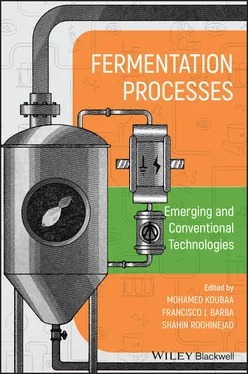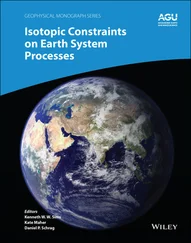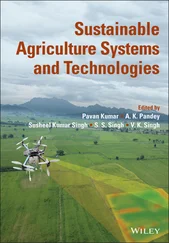Dorota Witrowa‐RajchertFaculty of Food Sciences, Department of Food Engineering and Process Management, Warsaw University of Life Sciences (WULS‐SGGW), Warsaw, Poland
Łukasz WoźniakDepartment of Fruit and Vegetable Product Technology, Institute of Agricultural and Food Biotechnology, Warsaw, Poland
Bioprocesses find many traditional or new applications in the agri‐food, chemical, pharmaceutical, and environmental industries. Enhancing these processes for better production of microbial biomass and/or products has interested many scientists in the last two decades. One of the strategies consists of changing the medium composition or the fermentation parameters (e.g. oxygenation, agitation, temperature, etc.), most of the time via a design of experiment approach. Besides, some emerging technologies (e.g. pulsed electric fields, ultrasounds, high hydrostatic pressure, microwaves, etc.) have shown their efficiency to enhance the fermentation processes. These technologies when applied at high intensities cause cell disintegration and find their applications in bioprocesses, for example, to produce sugar monomers from lignocellulosic biomass. Nonetheless, their application at sublethal levels may induce stress of microorganisms and affect the microbial growth and the formation of the products during fermentation. The beneficial effects of microbial stimulation by emerging technologies include mainly the shortening of the fermentation time, the acceleration of the substrate consumption, and the increase of the microbial biomass.
This book covers the principles of conventional fermentation processes, the major microorganisms used in bioprocesses, their implementation in industrial fermentation processes, the medium condition changes, and the use of emerging technologies for enhancing the fermentation processes. Besides, the mechanisms of action of the above‐mentioned emerging technologies are discussed.
This book is designed to assist scientists working on fermentation processes as well as those working in the food, nutraceutical, pharmaceutical, and beverage industries. The topics covered in this book are suitable for teaching in courses such as bioprocess technology, microbiology, new product development, and food processing.
We gratefully acknowledge the contribution of colleagues from all around the world, the cover designer Mohamed Messaoud, and the professional assistance provided by the staff of Wiley.
Mohamed Koubaa, Francisco J. Barba, and Shahin Roohinejad
1 Introduction to Conventional Fermentation Processes
Mohamed Koubaa
ESCOM, UTC, EA 4297 TIMR, Compiègne, France
Bioprocesses represent all the methods and techniques that use microbial, plant, or animal cells or their components (e.g. enzymes, proteins, genes, etc.) for the production of goods and services (Sindhu et al. 2017). Bioprocess technology is, in fact, an extension of the ancestral techniques used at the time to develop useful products (Kalaichelvan and Pandi 2019). Nowadays, microbial cells are not only used in common processes, such as for the production of alcoholic beverages (e.g. wine, beer, etc.) or dairy products (e.g. yogurt, cheese, etc.), but also to produce a wide diversity of complex molecules. In this sense, bioprocesses find many traditional or new applications in the following industries:
Agri‐food industry: production of animal proteins, amino acids, fermented foods and beverages, vitamins, enzymes, etc.
Chemical industry: production of organic acids, ethanol, solvents, polymers, biogas, etc.
Pharmaceutical industry: production of antibodies, vaccines, hormones, plasmids, steroids, etc.
Environmental industry: decontamination of wastewater, air, and soil; development of agricultural and industrial by‐products, etc.
In this respect, bioprocesses are exploited in three specific fields: fermentation processes, animal and plant cell cultures, and environmental bioprocesses. This chapter will mainly focus on conventional fermentation processes.
Most of the methods and techniques used in bioprocesses are based on fermentation technology. This is not surprising since the first ancestral processes were based on microbial fermentation. For most people, fermentation simply refers to the production of alcohol (beer and wine) or the deterioration of food by microorganisms (curd). Nevertheless, the word fermentation takes on a broader common industrial meaning. It is any process for producing a substance or biomass of cells on a large scale by using the culture of a microorganism, in aerobic or anaerobic conditions.
To be able to carry out these fermentations, it is imperative to cultivate microorganisms in tanks equipped with a certain number of more or less sophisticated systems; these tanks are called fermenters or bioreactors . Their role is to provide a controlled environment for optimal growth of microbial cells throughout the culture by constantly stirring the medium, infusing sterile air – in the case of aerobic fermentation – and controlling the temperature and pH of the fermentation broth. By using these tanks, contamination by other microorganisms is avoided by constantly maintaining asepsis conditions.
The first modern fermenters were designed in the 1950s to support the industrial production of penicillin and other newly discovered antibiotics. Since then, they have been able to control several other types of crops and to substantially increase the quantity of products marketed in each of the three fields of application of industrial bioprocesses mentioned above. Six major groups of products could then be obtained by fermentative processes, namely the production of (i) microbial biomass, (ii) microbial metabolites, (iii) microbial enzymes, (iv) recombinant proteins, (v) microbial plasmids, and (vi) bioconversion.
1.1.1 Production of Microbial Biomass
Commercial production of microbial biomass can be divided into two major processes: the production of viable microorganisms used primarily for fermentative applications (Vitorino and Bessa 2017) and the production of microbial cells, usually dead, that can serve as protein‐rich supplements (Matassa et al. 2016).
In the first case, we can cite several examples: the production of bakery yeasts for the production of bread, the production of yeasts to perform alcoholic fermentation (e.g. beers, wines, spirits, etc.), and the production of lactic acid bacteria for the manufacturing of cheese, yogurt, fermented meats (i.e. sausages), or fermented vegetables (e.g. sauerkraut, marinated pickles, etc.). Some food supplements composed of live lactic acid bacteria, also called probiotics , are produced by fermentation. They can be defined as live microorganisms, and the adequate amounts of them supply a health benefit to the host (Otles and Ozyurt 2019). Their role is to exert a beneficial effect by improving the quality of the intestinal flora. These microorganisms are usually supplied as a lyophilized powder in hermetically sealed sterile bags or containers. Generally, the name of ferments is given to microorganisms that serve to start a fermentation process (Koutinas 2017). Some microbial strains such as the bacterium Bacillus thuringiensis , whose spores produce a very effective toxin against pest larvae (biological insecticide), are also grown.
In the second case, it is a question of producing microbial biomass to exploit the nutritional potential of the proteins that it produces (Matassa et al. 2016). This biomass is incorporated into prepared foods to increase their protein content without significant fat intake, which improves their nutritional quality. The yeast Candida utilis is mostly used as a dietary supplement because of its exceptionally high protein content (50–55% of dry weight). This yeast can be used as a valuable raw material to produce various preparations enriched with valuable bioelements (e.g. selenium, magnesium, etc.). The use of such preparations in the human diet provides an interesting alternative to classical, pharmacological supplementation and prevents deficits of important elements, while their addition to feedstock significantly improves the results of animal production (Kieliszek et al. 2017).
Читать дальше












